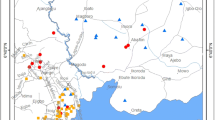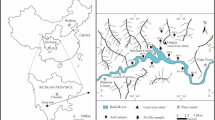Abstract
Lead contamination in topsoil of the mining and smelting area of Mitrovica, Kosovo, was investigated for total concentrations and chemical fractions by sequential extraction analysis, mineralogical fractions by X-ray diffraction (XRD) and scanning electron microscopy with energy-dispersive X-ray spectrometer (SEM-EDX). The study revealed that all samples contained Pb exceeding USEPA standard of 400 mg kg−1. The highest total concentration of Pb (125,000 mg kg−1) was the soil from the former smelter. Sequential extraction results showed that the predominant form of Pb was associated with Fe-Mn oxide-bound fraction which ranged from 45.37 to 71.61% of total concentrations, while carbonate and silicate Pb-binding fractions were dominant when physical measurements (XRD and SEM-EDX) were applied. Application of Pb isotope ratios (206Pb/207Pb and 208Pb/206Pb), measured by inductively coupled plasma mass spectrometry, identified that Pb contamination is originated from similar anthropogenic source. The results reflected that the Pb contamination in the soil of this area is serious. In order to provide proper approaches on remediation and prevention of health impacts to the people in this area, a continuous monitoring and health risk assessment are recommended.








Similar content being viewed by others
References
Abd-Elfattah, A., & Wada, K. (1981). Adsorption of lead, copper, zinc, cobalt, and cadmium by soils that differ in cation exchange materials. Journal of Soil Science, 32, 271–283.
Alpers, C. N., Blowes, D. W., Nordstrom, J. L., & Jambor, J. L. (1994). Secondary minerals and acid mine. In D. W. Blowes & J. L. Jambor (Eds.), The environmental geochemistry of sulfide mine-wastes, Short course handbook (Mineralogical Association of Canada) (pp. 247–270). Nepean: Mineralogical Association of Canada.
Brewer, P.A., Bird, G., & Macklin, M.G. (2016). Isotopic provenancing of Pb in Mitrovica, northern Kosovo: Source identification of chronic Pb enrichment in soils, house dust and scalp hair. Applied Geochemistry, 64, 164–175.
Chen, J., Tan, M., Li, Y., Zhang, Y., Lu, W., Tong, Y., et al. (2005). A lead isotopic record of Shanghai atmospheric lead emissions in total suspended particles during the period of phasing out of leaded gasoline. Atmospheric Environment,39(7), 1245–1253.
Chopin, E. I. B., & Alloway, B. J. (2007). Trace element partitioning and soil particle characterization around mining and smelting areas at Tharsis, Ríotinto and Huelva, SW Spain. Science of the Total Environment,373, 488–500.
Cicchella, D., Vivo, B. D., Lima, A., Albanese, S., McGill, R. A. R., & Parrish, R. R. (2008). Heavy metal pollution and Pd isotopes in urban soils of Napoli, Italy. Geochemistry: Exploration, Environment, Analysis. https://doi.org/10.1144/1467-7873/07-148.
Davis, A., Ruby, M. V., & Bergstrom, P. D. (1992). Bioavailability of arsenic and lead in soils from the Butte, Montana, mining district. Environmental Science and Technology,26, 461–468.
Dutrizac, J. L., & Jamber, J. L. (2000). Jarosites and their application in hydrometallurgy. In C. N. Alpers, J. L. Jamber, & D. K. Nordstrom (Eds.). Reviews in mineral geochemistry (Vol. 40, pp. 405–452).
Environmental Protection Agency. (2001). 40 CFR Part 745: Lead; identification of dangerous levels of lead. Federal Register,66(4), 1206–1240.
Ettler, V., Mihaljevič, M., & Bezdička, P. (2005). Contrasting lead speciation in forest and tilled soils heavily polluted by lead metallurgy. Chemosphere, 58, 1449–1459.
Ettler, V., Mihaljevič, M., & Komárek, M. (2004). ICP-MS measurements of lead isotopic ratios in soils heavily contaminated by lead smelting: Tracing the sources of pollution. Analytic and Bioanalytical Chemistry. https://doi.org/10.1007/s00216-003-2229-y.
European Environment and Health Information System (ENHIS), World Health Organization (WHO) (2007). Blood lead levels in children. Fact sheet no. 4.5 May 2007 Code RPG4 Chem_Ex1. http://www.euro.who.int/__data/assets/pdf_file/0004/97447/4.5.pdf. Accessed 10 May 2008.
Fayiga, A. O., Saha, U., & Ma, L. Q. (2011). Chemical and physical characterization of lead in three shooting range soils in Florida. Chemical Speciation and Bioavailability,23(3), 163–169.
Hopkins, V. (2016) Poisoned Roma in Kosovo await justice from UN. http://pristinainsight.com/prisoned-roma-kosovo-await-justice-un-mag/. Accessed 19 July 2018.
Johnson, D.L., & Bretsch, J.K. (2002). Soil lead and children’s blood lead levels in Syracuse, NY, USA. Environmental Geochemistry and Health, 24, 375–385.
Komarek, M., Ettler, V., Chrastny, V., & Mihaljevic, M. (2008). Lead isotopes in environmental sciences: A review. Environment International,34(4), 562–577.
Li, J., Li, K., Cave, M., Li, H. B., & Ma, L. Q. (2015). Lead bioaccessibility in 12 contaminated soils from China: Correlation to lead relative bioavailability and lead in different fractions. Journal of Hazardous Materials,295, 55–62.
Li, X., & Thornton, I. (2001). Chemical partitioning of trace and major elements in soils contaminated by mining and smelting activities. Applied Geochemistry,16(15), 1693–1706.
Ma, L.Q., & Rao, G.N. (1997). Chemical fractionation of cadmium, copper, nickel, and zinc in contaminated soils. Journal of Environmental Quality, 26(1), 259–264.
Monna, F., Lancelot, J., Croudance, I. W., Cundy, A. B., & Lewis, J. T. (1997). Pb isotopic composition of airborne particulate material from France and the Southern United Kingdom: Implications for Pb pollution sources in urban areas. Environmental Science and Technology,31, 2277–2286.
Monna, F., Loizeau, J. L., Thomas, B. A., Guéguen, C., & Favarger, P. Y. (1998). Pb and Sr isotope measurements by inductively coupled plasma–mass spectrometer: Efficient time management for precision improvement. Spectrochimica Acta, Part B: Atomic Spectroscopy,53(9), 1317–1333.
Nannoni, F., Protano, G., & Riccobono, F. (2011). Fractionation and geochemical mobility of heavy metals in soils of a mining area in northern Kosovo. Geoderma,161, 63–73.
National Research Council. (1993). Measuring lead exposure in infants, children and other sensitive populations. Washington, DC: National Academic Press.
OXALID (Oxford Archeological Lead Isotope Database) (2018). http://oxalid.arch.ox.ac.uk/
Qu, C., Wang, S., Ding, L., Zhang, M., Wang, D., & Giesy, J. P. (2018). Spatial distribution, risk and potential sources of lead in soils in the vicinity of historic industrial site. Chemosphere,205, 244–252.
Rieuwerts, J. S., Farago, M. E., Cikrt, M., & Bencko, V. (2000). Differences in lead bioavailability between a smelting and mining area. Water, Air, and Soil pollution,122, 203–229.
Ryan, J. R., Zhang, P., Hesterberg, D., Chuo, J., & Sayers, D. E. (2001). Formation of chloropyromorphite in a lead-contaminated soil amended with hydroxyapatite. Environmental Science and Technology,35, 3798–3803.
Spositio, G., Lund, L.J., & Chang, A.C. (1982). Trace metal chemistry in arid-zone field soils amended with sewage sludge I: Fractionation of Ni, Cu, Zn, and Pb in solid phases. Soil Science Society of America Journal, 46, 260–264.
Tessier, A., Campell, P. G. C., & Bisson, M. (1979). Sequential extraction procedure for the speciation of particulate trace metals. Analytical Chemistry,51, 844–850.
Tsaihwa, J., & John, L. (1972). Lead isotopes in North American coals. Science,176, 510–511.
Véron, A., Flament, P., Bertho, M. L., Alleman, L., Flegal, R., & Hamelin, B. (1999). Isotopic evidence of pollutant lead sources in Northwestern France. Atmospheric Environment,33, 3377–3388.
WHO ECEH, Bonn office (2005). Mission report: Lead (Pb) crisis in the United Nation administered province of Kosovo.
Wong, S.C., Li, X.D., Zhang, G., Qi, S.H., & Min, Y.S. (2002). Heavy metals in agricultural soils of the Pearl River Delta, South China. Environmental Pollution, 119, 33–44.
Yu, S., He, Z.L., Huang, C.Y., Chen, G.C., & Calvert, D.V. (2004). Copperfractionation and extractability in two contaminated variable charge soils. Geoderma, 123, 163–175.
Acknowledgements
This work was supported by GIST Research Institute (GRI) grant funded by Gwangju Institute of Science and Technology (GIST), Korea, in 2018.
Author information
Authors and Affiliations
Corresponding author
Rights and permissions
About this article
Cite this article
Prathumratana, L., Kim, R. & Kim, KW. Lead contamination of the mining and smelting district in Mitrovica, Kosovo. Environ Geochem Health 42, 1033–1044 (2020). https://doi.org/10.1007/s10653-018-0186-9
Received:
Accepted:
Published:
Issue Date:
DOI: https://doi.org/10.1007/s10653-018-0186-9




